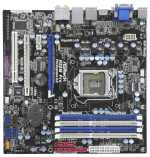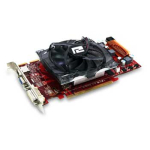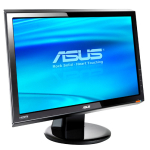System Buyers' Guide: PCs for Under $1000
by Sean Hollister on February 12, 2010 2:00 AM EST- Posted in
- Guides
Intel Mainstream PC
If you have a bit more to spend, the next step up the pricing ladder brings a lot to the table: the Intel Core i3-530, a best-in-class H55 motherboard, a 1080p LCD monitor and a bang-for-the-buck GPU to power it. Now we're talking.
| Intel Mainstream System | ||
| Hardware | Component | Price |
| Processor | Intel Core i3-530 (2.93GHz x2, 32nm, 4MB L3 Cache) |
$120 |
| Cooling | CPU Retail HSF | $0 |
| Video | PowerColor Radeon HD 4850 512MB | $100 |
| Motherboard | ASRock H55M Pro LGA1156 Micro ATX | $95 |
| Memory | G.Skill Ripjaws 4GB DDR3-1600 F3-12800CL9D-4GBRL | $105 |
| Hard Drive | WD Caviar Blue 500GB WD5000AAKS | $54 |
| Optical Drive | Sony Optiarc Model AD-7240S-OB 24X DVDRW SATA | $28 |
| Audio | Onboard | $0 |
| Case | Cooler Master Centurion 5 CAC-T05-UW Mid Tower ATX | $55 |
| Power Supply | OCZ ModXStream Pro 500W ATX12V SLI Certified, CrossFire Ready, 80 PLUS Certified Modular Active PFC (before $25 Rebate) | $65 |
| Base System Total | $622 | |
| Display | ASUS VH226H Black 21.5" 2ms(GTG) HDMI Widescreen 16:9 LCD (1920x1080) (before $20 Rebate) | $170 |
| Speakers | Cyber Acoustics CA-3090 26W 2.1 Speakers | $21 |
| Input | Microsoft B2L-00045 Comfort Curve Black USB Keyboard and Optical USB Mouse - OEM | $22 |
| Operating System | Microsoft Windows 7 Home Premium OEM 1-Pack (for System Builders) | $105 |
| Complete System Bottom Line | $940 | |
| Plus Estimated Shipping (within Continental U.S.) | $990 | |
| Rebates | -$45 | |
| Bottom Line (less tax, if applicable) | $945 | |
Though its price and associated requirements (LGA1156, DDR3) make it prohibitively expensive for entry-level rigs, we fully expect the Core i3-530 to be the starting point for bang-for-the-buck PC building guides around the globe anyhow. That's because at only $125, the Core i3-530 is not only the fastest dual-core processor available today, but also—with two logical threads per core—performs on par with the best budget quad-cores in most benchmarks. If that weren't enough, it features an on-die integrated graphics solution that rivals the best IGPs AMD has to offer (which isn't saying much, sadly) and it does it all while consuming less power than practically any other mainstream CPU out there. And thanks to its 32nm process and a 22x multiplier, it also overclocks to 4GHz using the stock cooler (YMMV).
 |
Paired with this Clarksdale wunderkind is the ASRock H55M Pro, the best, least-finicky H55 motherboard we've yet tested. Featuring the onboard VGA, DVI and HDMI video-out connectors and Flexible Display Interface needed to make use of the Core i3's Intel HD IGP, the board also features a superb layout. It has a pair of PCIe x16 slots (one at x16, one at x4), a PCIe x1 and a PCI slot arranged in a configuration where none of its ports are liable to be covered by expansion cards. Speaking of ports, the board comes with five neatly arranged SATA 3GB/s ports on the board and three USB 2.0 headers, with an eSATA, six USB2.0 ports, a combo PS/2, a single 1394a and optical S/PDIF out on the rear panel. 7.1 channel HD audio duties fall to the VIA VT1718S, while a Realtek 8111DL handles Gigabit Ethernet. There's even a TPM header.
While the board supports all current LGA 1156 Core i7, i5 and i3 processors, up to 16GB of DDR3-2600 memory and even Quad CrossFireX, it's not really a board you'd slot premium DIMMs or multiple GPUs into. We found it to have only moderate overclocking potential, and the PCIe x4 puts the kibosh on even regular CrossFire giving you your money's worth. But for $95, it's a wonderful board on which to build a mainstream PC.
 |
Given the fidelity of the onboard Intel HD Graphics, and assuming you don't care to play modern games in excess of 1024x768 resolution at minimum settings, a dedicated graphics card is honestly quite optional in a Core i3 and H55-equipped mainstream PC. Even without it, you can bitstream Dolby TrueHD and DTS HD-MA over the HDMI connection, handle hardware accelerated decoding of H.264/VC-1/MPEG2 streams, and drive large desktop screens. But because last year's mainstream rig included our editor-favorite Radeon HD 4770, it was hard to pass up the even more powerful, game-crunching $100 Radeon HD 4850. If you'd rather, you can get the slower Radeon HD 5670 for the same price and have access to DX11, Eyefinity and possibly 3D Blu-ray support later this year, or add $40 and get the best of both worlds with the faster Radeon HD 5750 1GB. Alternatively, you can save the $100, or put it towards one of the other goodies in our upgrade list on page 6. But know that when we were looking for a video card with enough value to automatically deserve a place in our mainstream rig, we immediately gravitated towards the 4850.
 |
While all other base components are the same known quantities we used for our entry-level rigs, we upgraded two peripherals for our mainstream PCs that deserve mention here. First, because in-monitor speakers are notorious for their low quality, we bring back last year's Cyber Acoustics CA-3090 2.1 speaker system, a fantastic value even at $20 (compared with $16, nine months ago). Second, we upgraded the LCD monitor to the ASUS VH226H. At $150 after rebate, the VH226H offers far more than $30 worth of extra value over the $120 VW193TR it replaces: it's a 21.5", 1920x1080 TN panel with a 2ms grey-to-grey response time, 1000:1 typical contrast ratio, and the all-important HDMI 1.3 input jack alongside standard DVI and VGA.










86 Comments
View All Comments
poohbear - Friday, February 12, 2010 - link
Thank you for putting this article up, i was waiting for one of your system builder guides as a rough reference as they're usually on the money, this article was no exception.:) Alot of solid info there, will definitely use it as a reference for the next couple of months when people ask for advice (all my friends and family want a budget PC, i only know enthusiast parts! lol)juampavalverde - Friday, February 12, 2010 - link
Congrats for the first article Sean, it feels very "anandtech" like.papapapapapapapababy - Friday, February 12, 2010 - link
all over the place. who makes this lame shopping list? example... the LGA 775 motherboard is a terrible choice, TERRIBLE for like 2 bucks you have this one > GA-EP43T-USB3 LGA 775 the difference ? nah not much, just that onboard NEC uPD720200 host controller ( that means USB3 support ) The funny thing, im just a guy from Argentina (cant even buy the dam board) even then i know how to build a better pc than the experts over here. great job Anad...piasabird - Friday, February 12, 2010 - link
If you are going to look at an i3 530 why not also look at the E7500 and see which processor does best for the money.It seems like they would be fairly compatible at about the same price. Why go to a new somewhat experimental H55 motherboard if there is not enough of an improvement?
johnsonx - Friday, February 12, 2010 - link
While it's true that MOST power supplies that come with cases are nearly worthless, there are some exceptions. Many Antec and some Coolermaster cases come with perfectly nice power supplies. The Antec NSK4480 comes with an EarthWatts 380 for only $70 (http://www.newegg.com/Product/Product.aspx?Item=N8...">http://www.newegg.com/Product/Product.aspx?Item=N8...There are other examples as well.
johnsonx - Friday, February 12, 2010 - link
oops, the closing paren got included with the URL above, here it is again:http://www.newegg.com/Product/Product.aspx?Item=N8...">http://www.newegg.com/Product/Product.aspx?Item=N8...
JarredWalton - Friday, February 12, 2010 - link
When we were putting the guide together, I actually looked at that exact system. You'll notice the regular price is listed at $100? That's what it was two days ago, which is why I didn't bother Sean with the change. I figure for the $20 extra, a 500W PSU was a better choice. For $80 (plus shipping), it's a much more attractive option, provided you don't want to upgrade to a high-end GPU down the road.The 380W is good for something like a 5770 with an i3/i5 CPU or Phenom II X4 level CPU, but if you overclock the CPU you're going to be pushing it very hard. Add in something in the 5850 class and you'd likely peak at close to 100% power draw, if not slightly more. On the other hand, if you just want to run at stock with IGP, such a setup is a great idea. (I wish more cases shipped with 80 Plus certified PSUs... a year ago, I recall a few cases like that falling into the $65-$75 shipped range.)
Bugler - Friday, February 12, 2010 - link
I really enjoy reading these guides and the thought process that goes into your builds. My last build was 2004, which I am still using; however, I want to upgrade, the board, ram, cpu. etc.At the time I built back then, I tried to use some of the best components to make it easier to upgrade in the future. I am just not certain which parts I can retain with my rebuild.
I have a large Cooler Master Stacker full tower case, a OCZ Power Stream 520w power supply, a 7.1 channel Sound blaster Audigy2 zs gamer PCI sound card, and an eVGA nvidia geforce 6800 GT 256mb GDDR graphic card that I am hoping to reuse. Do you guys see any problems with me using these components in your mid level build package option?
I admit, I have not stayed up on the knowledge aspect of components specs the past few years. My video card is bus APG 4x/8x but does output to DVI.
Also, my CPU heatsink is the Theralright XP-90 which has been sitting on my 939 socket AMD for the fast five years. Is that something I can reuse in this build?
Thank you in advance guys.
FlyTexas - Friday, February 12, 2010 - link
Keep the case and power supply, maybe the Sound Blaster card and DVD drive if you really want, dump everything else.Why? First, AGP is long gone, PCI-Express is now how video cards are installed. Built in graphics won't be as good as your former video card, but they'll be close. For $100, the ATI 4850 will run rings around your old card.
Second, modern hard drives are a lot faster than they were in 2004, don't hobble a new system with a 5 year old drive.
You can probably reuse your old heatsink and fan if you go AMD, but do you really want to? The fan is 5 years old, it wasn't designed or certified for modern CPUs.
Bugler - Saturday, February 13, 2010 - link
Thank you.